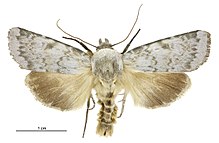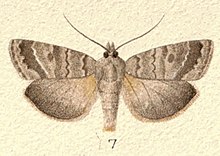| Physetica caerulea | |
|---|---|

| |
| Male | |

| |
| Female | |
| Scientific classification | |
| Domain: | Eukaryota |
| Kingdom: | Animalia |
| Phylum: | Arthropoda |
| Class: | Insecta |
| Order: | Lepidoptera |
| Superfamily: | Noctuoidea |
| Family: | Noctuidae |
| Genus: | Physetica |
| Species: | P. caerulea |
| Binomial name | |
| Physetica caerulea (Guenee, 1868) | |
| Synonyms | |
| |
Physetica caerulea is a species of moth of the family Noctuidae. It is endemic to New Zealand and can be found from the centre of the North Island south, including the South and Stewart Islands. The adult moths are variable in appearance but can be distinguished by the bluish tinge to the forewings as well as the underside buff colour. However this species does have several forms including a very dark bluish black form, a brownish form and a green-brown form. It lives in open habitats and can be found in tussock grasslands and dunes and can normally be found from altitudes of sea level up to 900 m. Adults of this species are on the wing from August to April. As at 2017, the life history of is unknown as are the host species of its larvae. However it has been hypothesised that the larval host species is a tomentose plant.
Taxonomy
This species was first described by Achille Guenée in 1868 and originally named Spaelotis caerulea. In 1887 Edward Meyrick placed this species in the Physetica genus. In 1906 George Howes, thinking he was describing a new species, named it Physetica hudsoni. This latter name was synonymised by George Hudson in 1928 into Physetica caerulea. In 1988 J. S. Dugdale confirmed this placement. In 2017 Robert Hoare undertook a review of New Zealand Noctuinae and also agreed with the placement of this species in the genus Physetica. The male holotype specimen is held in the Natural History Museum, London.
Description


Hudson described this species as follows:
The expansion of the wings is 1+1⁄2 inches. The fore-wings are rich, glossy reddish-brown with several scattered whitish scales ; there is a distinct yellow mark on the costa at about one-fourth, forming the beginning of a broken transverse line ; the orbicular is small, round, and yellowish ; the reniform is small, crescentic and yellowish, the space between the orbicular and the reniform is very dark blackish-brown; beyond the reniform there is a conspicuous white mark on the costa forming the beginning of a second broken transverse line ; a third shaded line is situated near the termen. The hind-wings are pale brown with a dark spot in the middle, very conspicuous on the under surface.
The wingspan of the adult male is between 32.5 and 41 mm and for the female the wingspan is between 33.5 and 45 mm. The adults of this species are variable in appearance but can be distinguished by the bluish tinge to the forewings as well as the underside buff colour. However this species does have several forms including a very dark bluish black form, a brownish form and a green-brown form.
Distribution
This species is endemic to New Zealand. This species can be found from the centre of the North Island south, including the South and Stewart Islands.
Habitat
This species lives in open habitats and can be found in tussock grasslands and dunes. It can normally be found from altitudes of sea level up to 900 m, however there is one record of it being collected at 1385 m.
Behaviour
Adults of this species are on the wing from August to April.
Life history and host species
The life history of this species is unknown as are the host species of its larvae. However it has been hypothesised that the larval host species is a tomentose plant.
References
- ^ Robert Hoare (23 June 2017). "Noctuinae (Insecta: Lepidoptera: Noctuidae) part 1: Austramathes, Cosmodes, Proteuxoa, Physetica" (PDF). Fauna of New Zealand. 73. Illustrator: Birgit E. Rhode. Manaaki Whenua – Landcare Research: 41–43. doi:10.7931/J2/FNZ.73. ISSN 0111-5383. OCLC 1002177011. Wikidata Q44893580.
- Achille Guenée (1868). "New species, &c., of heterocerous Lepidoptera from Canterbury, New Zealand, collected by Mr. R. W. Fereday". Entomologist's Monthly Magazine. 5: 38. ISSN 0013-8908. Wikidata Q104214297.
- Edward Meyrick (1887). "Monograph of New Zealand Noctuina". Transactions and Proceedings of the New Zealand Institute. 19: 5–6. ISSN 1176-6158. Wikidata Q104048034.
- George Howes (1906). "Some new species of Lepidoptera". Transactions and Proceedings of the New Zealand Institute. 38: 510. ISSN 1176-6158. Wikidata Q107706217.
- Hudson, G. V. (1928), The butterflies and moths of New Zealand, Illustrator: George Hudson, Wellington: Ferguson and Osborn Limited, p. 59, LCCN 88133764, OCLC 25449322, Wikidata Q58593286
- Dugdale , J. S. (23 September 1988). "Lepidoptera - annotated catalogue, and keys to family-group taxa". Fauna of New Zealand. 14. Department of Scientific and Industrial Research: 209. doi:10.7931/J2/FNZ.14. ISSN 0111-5383. Wikidata Q45083134.
- George Vernon Hudson (1898), New Zealand moths and butterflies (Macro-lepidoptera), Illustrator: George Hudson, London, p. 8, doi:10.5962/BHL.TITLE.7912, OCLC 980865393, Wikidata Q19073637
{{citation}}: CS1 maint: location missing publisher (link) - "Physetica caerulea (Guenee, 1868)". www.nzor.org.nz. Landcare Research New Zealand Ltd. Retrieved 2017-07-06.
| Taxon identifiers | |
|---|---|
| Physetica caerulea | |